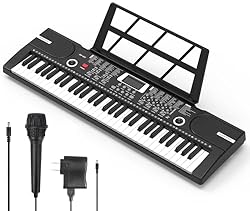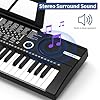Table of Contents
Developing Hand Coordination on the Piano
Mastering the piano requires not just musical intelligence and emotional sensibility, but also a high degree of physical coordination. Perhaps one of the most challenging aspects for beginners as well as experienced pianists is developing precise hand coordination. This skill is essential for playing complex pieces where each hand performs seemingly independent tasks. The journey to achieving effortless synchronization between both hands can significantly enhance one’s playing style and efficiency.
Exercise 1: Parallel Scale Practice
Begin by practicing parallel scales with both hands. Start slowly, ensuring that each finger from both hands presses the keys simultaneously. It is vital to use a metronome to maintain a consistent speed. Gradually increase the tempo as your synchronicity improves. This exercise develops basic coordination and familiarizes each hand with similar movements across the piano keys.
Yamaha Arius Series 88-Key Weighted Action Upright Digital Piano, CFX Concert Grand Piano Voice, 3-Pedal Unit, Bench Included, Classic Upright Design, Black YDP145B
17% OffFree Piano - Learn to Play Piano
$0.00 (as of November 22, 2025 22:56 GMT -08:00 - More infoProduct prices and availability are accurate as of the date/time indicated and are subject to change. Any price and availability information displayed on [relevant Amazon Site(s), as applicable] at the time of purchase will apply to the purchase of this product.)Classical Piano for Sleep and Relaxation
$9.99 (as of November 22, 2025 22:56 GMT -08:00 - More infoProduct prices and availability are accurate as of the date/time indicated and are subject to change. Any price and availability information displayed on [relevant Amazon Site(s), as applicable] at the time of purchase will apply to the purchase of this product.)61 keys keyboard piano, Electronic Digital Piano with Built-In Speaker Microphone, Sheet Stand and Power Supply, Portable piano Keyboard Gift Teaching for Beginners
$164.00 (as of November 22, 2025 23:10 GMT -08:00 - More infoProduct prices and availability are accurate as of the date/time indicated and are subject to change. Any price and availability information displayed on [relevant Amazon Site(s), as applicable] at the time of purchase will apply to the purchase of this product.)Exercise 2: Contrary Motion Scales
Contrary motion involves playing scales with both hands moving in opposite directions. Start with both thumbs on middle C, moving outwards to the respective high and low Cs and back to middle C. This exercise enhances your ability to manage different spatial movements simultaneously, which is crucial for improving overall hand coordination.
Exercise 3: Hanon Exercises
Hanon exercises are designed to improve finger dexterity, strength, and independence, which directly contributes to better hand synchronization. Each exercise becomes progressively complex, which is excellent for advancing your skills. Focus on playing each note with clarity and precision, and ensure the movements are perfectly synchronized across both hands.
Exercise 4: Rhythmic Variation Practice
This exercise involves playing the same notes with different rhythmic patterns in each hand. For example, the right hand could play quarter notes while the left plays eighth notes. This type of practice challenges and enhances your ability to keep time independently with each hand, a key component of hand coordination.
Exercise 5: Chord Inversions
Practice playing chord progressions with both hands, using various inversions. Start with simple triads (major and minor) and progress to more complex chords like sevenths and diminished chords. Each hand should play different inversions simultaneously. This exercise not only assists in synchronization but also in developing a deeper understanding of harmonic structures.
P71 Digital Piano Review and Guide
$0.00 (as of November 22, 2025 14:40 GMT -08:00 - More infoProduct prices and availability are accurate as of the date/time indicated and are subject to change. Any price and availability information displayed on [relevant Amazon Site(s), as applicable] at the time of purchase will apply to the purchase of this product.)Wicked - A New Musical Songbook by Stephen Schwartz | Piano Vocal Selections with 13 Broadway Hits | Sheet Music for Piano Voice and Guitar | Authentic Arrangements for Performers Students and Fans
31% OffReady for Theory Level 3 Piano Review Book (Ready for Theory Piano Review Books)
$12.95 (as of November 22, 2025 14:46 GMT -08:00 - More infoProduct prices and availability are accurate as of the date/time indicated and are subject to change. Any price and availability information displayed on [relevant Amazon Site(s), as applicable] at the time of purchase will apply to the purchase of this product.)The Piano Proficiency Exam Review Book
$14.57 (as of November 22, 2025 14:43 GMT -08:00 - More infoProduct prices and availability are accurate as of the date/time indicated and are subject to change. Any price and availability information displayed on [relevant Amazon Site(s), as applicable] at the time of purchase will apply to the purchase of this product.)Exercise 6: Imitation Practice
One hand plays a simple melody or pattern, and the other hand tries to replicate it immediately. Start with simple patterns and gradually increase complexity as your coordination improves. Imitation challenges your ears and hands to work closely in unison, building synchronization.
Exercise 7: Ensemble Playing
Playing with a metronome is an effective initial step, but nothing replaces the complexity of playing with other musicians. Try to engage in ensemble playing or duets. This real-time practice encourages you to adapt and synchronize not only both hands but also with other players, which can significantly improve your timing and coordination abilities.
Practicing Scales with Both Hands Together
Developing coordination between both hands is crucial for proficient piano playing. One effective way to enhance this skill is by practicing scales with both hands simultaneously. This technique not only improves finger independence but also aids in understanding and managing different key signatures.
Mirror Scales
Begin by playing mirror scales, where both hands start from the same note in the middle of the keyboard and move outward in opposite directions. For example, start both thumbs on Middle C, then move one hand up to D while the other moves down to B, and continue in opposite directions. This will help you understand the relative position of each hand.
Parallel Scales
Next, graduate to parallel scales, where both hands play the same notes but in parallel motion. Start both thumbs on Middle C and play the C major scale up and down the keyboard. Ensure each finger lands on the corresponding keys at the same time in both hands. This practice reinforces finger strength and precision.
Contrary Motion Scales
Move on to contrary motion scales, where your hands move in opposite directions from the same starting note. This builds the ability to manage different keys and modal patterns and hones your spatial awareness and timing.
Hands Together with Different Rhythms
Once comfortable, integrate different rhythms in each hand. For instance, play quarter notes in the left hand and eighth notes in the right. This exercise challenges and improves your rhythmic independence and coordination.
Chromatic and Advanced Scales
As proficiency develops, incorporate chromatic and advanced scales, such as the blues or pentatonic scales. Execute these scales with each hand together, initially at a slow tempo and increasing speed as competence allows. These scales provide nuanced challenges in finger placement and movement.
Tips for Playing Complex Rhythms with Ease
Mastering complex rhythms begins with breaking down the rhythms into simpler components. Start by playing the rhythm very slowly, ensuring each note is perfectly timed. Gradually increase the tempo as you get more comfortable, using a metronome to keep your pacing accurate. This step-by-step pacing helps solidify muscle memory and accuracy.
A metronome is a vital tool for keeping consistent time. When learning a new, complex rhythm, set the metronome to a slow speed that allows you to play comfortably. Gradually increase the speed as your accuracy improves. This gradual increase helps you adapt to playing at performance speed without sacrificing rhythm accuracy.
Before playing the notes on the piano, practice the rhythm by tapping it out on a flat surface. Count out loud as you tap. This method enables you to internalize the rhythm and understand its nuances. Once confident, transfer this understanding to the piano keys.
Complex rhythms can often be broken down into smaller, more manageable parts. Identify and isolate these segments, practice them individually, then slowly combine them. This strategy reduces the learning curve and clearly identifies areas that require more focus.
Varying the dynamics (loudness and softness) while practicing can deepen your understanding of the rhythm and how it interacts with the melody. Start with a moderate dynamic and experiment with crescendos and decrescendos to enhance musical expression.
Incorporating body movements like clapping, snapping, or foot tapping can make learning complex rhythms more intuitive. Body percussion helps bridge the gap between theoretical knowledge and practical application, making the rhythms easier to internalize and recall.
Listening to professional recordings of pieces that use the rhythm you’re learning can be incredibly beneficial. It not only provides a clear example of how the rhythm should sound but also showcases different interpretations and styles, offering a broader musical context.
Regular feedback from a teacher or a peer helps pinpoint areas in need of improvement and affirms what aspects are well executed. Furthermore, maintaining a consistent practice schedule is crucial. Regular repetition reinforces what you’ve learned and increases conviction in your playing.
Breaking Down Songs to Improve Coordination
One of the most effective methods for improving hand coordination on the piano is by breaking down songs into manageable components. This process not only helps in mastering complex pieces but also substantially enhances hand independence and control. Here’s how to break down songs to benefit hand coordination:
Begin with a song that aligns with your skill level. Selecting an overly challenging piece can be discouraging if you’re not yet ready to handle the intricacies.
Divide the song into sections. Break it down into smaller, more manageable parts. This could be verse by verse, line by line, or even measure by measure, depending on the complexity of the piece.
Start practicing each segment with one hand at a time. This approach allows you to focus on the technical demands and unique rhythms of each hand without the added complication of coordinating with the other hand.
Slow down your practice tempo. Playing slowly helps in building muscle memory and ensures accuracy and precision. It’s vital to feel confident and comfortable with each note and rhythm at a slow pace before speeding up.
Once you feel confident with each hand separately, begin to practice the segments with both hands together. Continue at a slow pace initially. Gradually increase the tempo as your coordination improves.
Incorporate a metronome into your practice. Starting at a slow tempo, use the metronome to ensure consistent timing. Incrementally increase the metronome speed as you build coordination and comfort.
Regularly revisit each segment even after you have moved on. This maintains muscle memory and coordination. Over time, integrate the pieces to form larger sections of the song until you can play the entire piece smoothly.
Recording your practice sessions and listening back can be incredibly beneficial. It provides an opportunity to critique your performance objectively, allowing you to notice aspects of your coordination that might need further improvement.
Gradually Increasing Speed
Initially, focus on playing piano pieces or exercises slowly and accurately. Begin with a tempo where you can control every note and maintain proper hand coordination. As you grow more comfortable, gradually increase the metronome speed by small increments. This stepwise increase helps build muscle memory and refine motor control.
Use tools like a metronome to keep your tempo consistent. After achieving proficiency at a slower speed, increase the tempo slightly, ensuring accuracy is maintained. This process should be repeated until the target speed of the piece is achieved, but never sacrifice precision for speed. Throughout, pay special attention to maintaining an even tone and dynamics across both hands.
Increasing Complexity
Start with simple pieces or scales to develop basic coordination. As confidence and skill improve, introduce more complex compositions involving wider hand movements, contrasting rhythms, or simultaneous independent hand movements. Pieces that incorporate polyrhythms or contrapuntal forms are excellent for advancing hand independence.
Progress to compositions with increased fingering complexity, multiple key changes, or varying tempos. Also, practice pieces that require different playing techniques in each hand, pushing your coordination and adaptability. Challenges like these aid in developing not just technical ability, but also cognitive processes essential for high-level piano playing.
Conclusion
Developing hand coordination on the piano requires persistent practice and a focused approach. By consistently practicing scales and arpeggios, engaging in hand independence exercises, and incorporating slow, deliberate practice of complex pieces, improvement can be seen over time. Additionally, the use of metronome to keep time and challenging oneself with various musical styles can significantly enhance coordination. Remember, regular feedback from a trained instructor can provide valuable insights and corrections, accelerating the learning process.
































